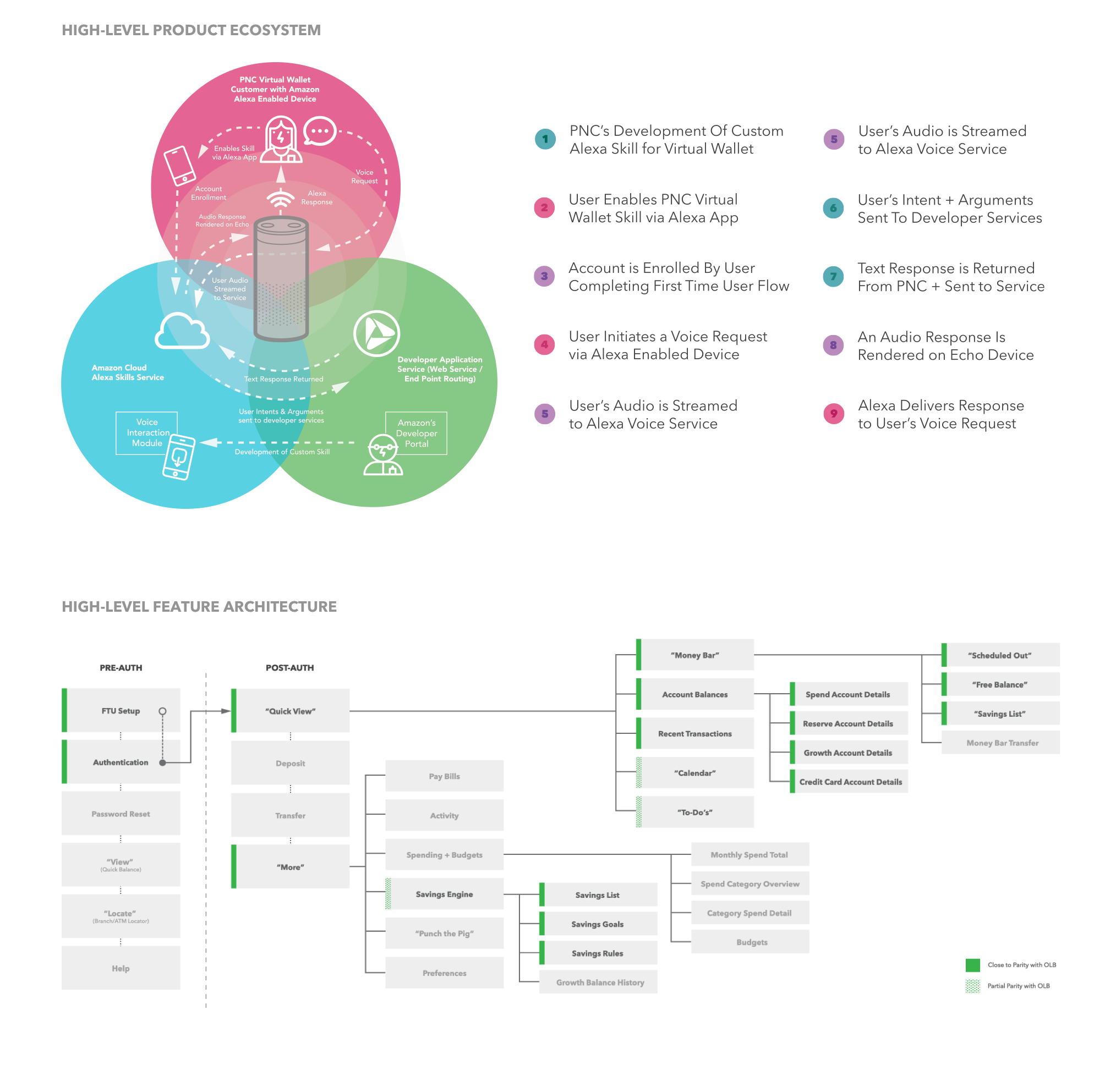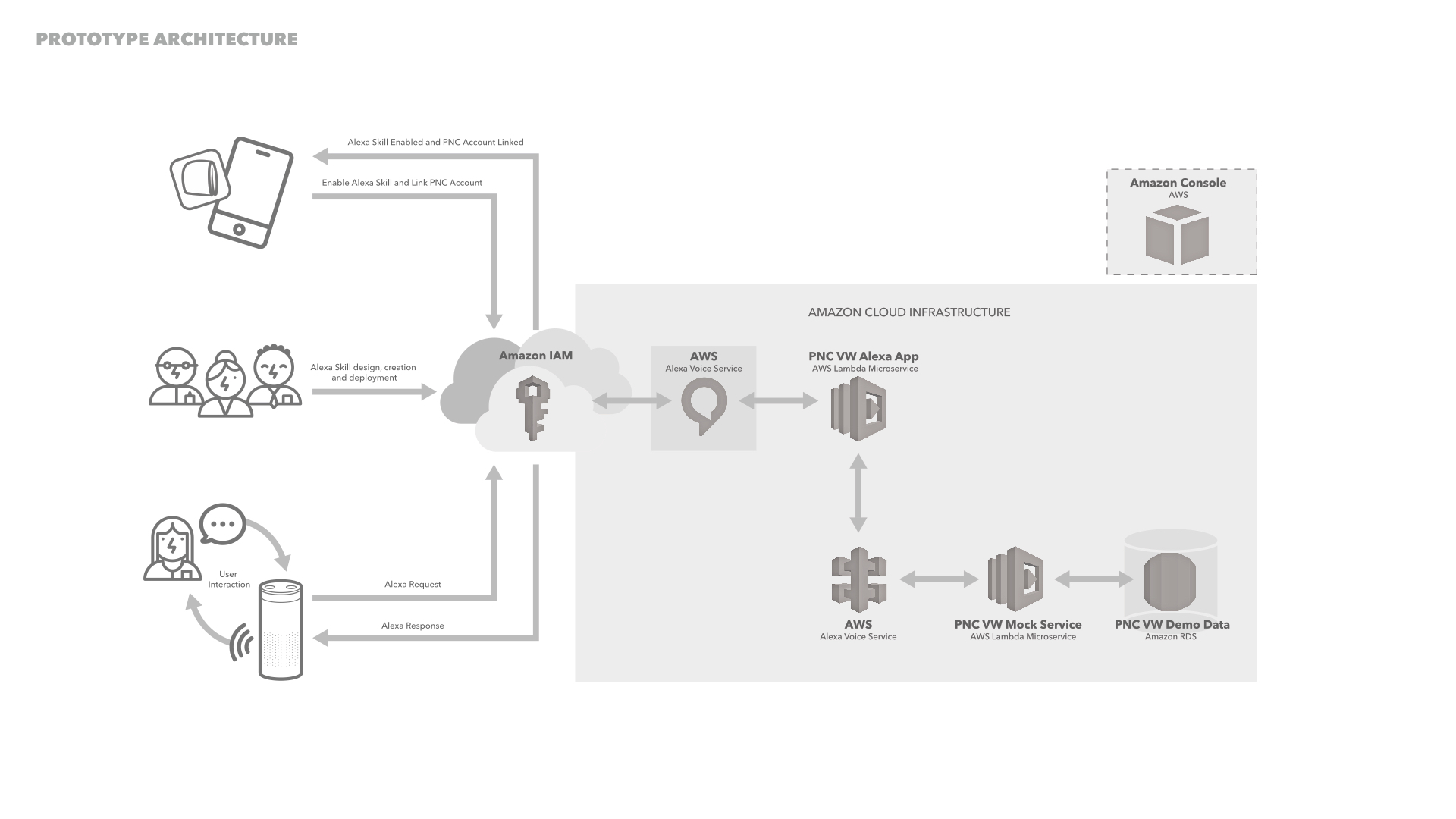
Virtual Wallet VUI

Virtual Wallet VUI
A voice user interface for personal financial management.
PROJECT DESCRIPTION | I was the team lead on this R&D project that was completed in late 2017 through PNC's iLab. Through this project we developed a functioning Amazon Alexa skill and conducted usability testing and research to explore how PNC might provide new conversational interfaces for consumer products and services.
OPPORTUNITY STATEMENT | The market is currently witnessing a surge of voice-based application interfaces that do not require a graphical user interface (GUI). While conversational interfaces are not a new phenomenon, they have recently spread into everyday mainstream activities and the devices that enable them. Pioneers of the industry, including Google, Slack, WeChat, Facebook Messenger, Microsoft, and Amazon, are setting consumer expectations through bots, virtual assistants, and invisible apps. Due to the significant leaps being made in Natural Language Processing and Understanding (NLP/NLU) technologies, the work and skill-level needed to build out these interfaces has been drastically reduced. The project explored approaches that the business could use to capitalize on conversational interface applications for financial products and services, and the feasibility and challenges involved in each approach.

By creating testable prototypes for conversational interfaces, we explored new ways to engage customers in the future. Through the process of research, design, development, testing, and refinement, we were able to gather quantitative and qualitative findings along the way. These findings were synthesized and used as input for the creation of internal standards and best practices for PNC Conversational Interfaces.
PROJECT FOCUS STATEMENT | Use existing hardware/software capabilities of Amazon’s Alexa Skill Kit, the current set of PNC Virtual Wallet APIs, and following PNC architectural practices to build an MVP for a conversational interface to PNC Virtual Wallet.
INTERFACE CONSIDERATIONS | Virtual Wallet was originally designed and built in 2009 as a desktop-based personal finance management tool that has evolved over time by being redesigned and optimized for new digital interfaces. The product’s user interface (UI), navigation (IA), and tools (UX), however, remain heavily reliant on visual design in the form of color-coding and charts to distill complicated financial information in a more user-friendly way. Due to the product's unique GUI, it's available APIs, and current user demographics, Virtual Wallet was chosen as the first PNC product to be adapted as a voice interface.
This section outlines a number of design, development and broader ecosystem considerations for a VUI based Virtual Wallet release.

Virtual Wallet specific considerations and challenges:
- Interactive Elements
- "Drag" of the money bar, spending zone, punch the pig, etc.
- Color-Coding
- primary accounts and account states (scheduled out, danger day, savings list), transaction categorization, error state messages
- PNC + VW Branding
- graphic elements, logos, icons, imagery, etc.
- IA and Navigation
- main menu, secondary tasks, naming conventions
- Naming Conventions
- “Spend” vs. “Checking”, “Free” vs. “Scheduled Out”, “Wishlist”, etc.
- Consistent user Flows/UX
- paying a bill, sending money, transferring money
- Clarity of Content
- numbers, account nicknames, system prompts, etc.
Product Consistency:
- IA and UX of Virtual Wallet product offering across channels
- VW user-base expectations
- User flows for VW + OLB features and functionalities
- PNC Brand Guidelines
Numerical Utterances:
- Amazon Alexa standards for how alphanumeric information, such as dollar amounts, are communicated via VUI
- Transaction Information made available (transaction details) from Yodlee and merchants
- Alignment with online, mobile, and ATM interface conventions and information display standards
Technology:
- PNC API set availability
- PNC architecture standards
- AWS + ASK - developer kit capabilities
- PNC coding standards / best practices availability
Security:
- PNC’s product and channel authentication standards and policies
- Amazon Developer Kit Constraints
- Conversational constraints
- Market scan of other Financial Institution Alexa Skill (Capital One)
- Cloud-based integrations requirements
PROTOTYPE OVERVIEW | Requirements & Features

Prototype Requirements:
Design: Translate digital graphical user interface from virtual wallet online banking to conversational voice interface, keeping in tact PNC’s IA, UX and UI.
Product: Identify user expectations and awareness along with selecting the right feature set.
Development: Create the prototype in a way that utilizes PNC standards via architectural, coding and general technology development best practices
Prototype Features:
Skill Setup: First time user set-up via the Alexa mobile app allows for users to authenticate, enroll and link their Virtual Wallet account with Alexa, and create a 4-digit Alexa PIN to access their account information using the channel.
Account Balance/Detail: Provides user with access to their basic account information regarding their balances for their PNC Virtual Wallet Spend, Reserve, and Growth, and Credit Card accounts.
Transaction Detail: Provides user with access to their recent transaction details within their PNC Virtual Wallet Spend, Reserve, Growth, and Credit Card accounts.

PROTOTYPE INTERFACE | Voice Interface + Skill Setup

PROTOTYPE TESTING + CONSUMER RESEARCH | To gather feedback on the current Virtual Wallet Alexa Skill prototype and understand customers’ needs, expectations, and desires for voice interfaces, we conducted a series of usability tests, qualitative research sessions, and product surveys. The findings from these activities resulted in:
- Refinements to the prototype VUI (updates to utterances and terminology)
- A detailed report outlining front and back-end considerations for the business team
- Conversational Interface guidelines and best practices for PNC products and services
- Business case and product product roadmap





